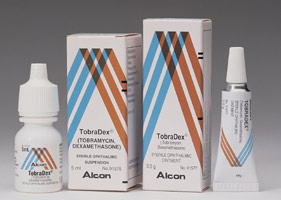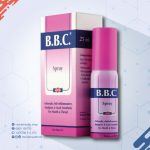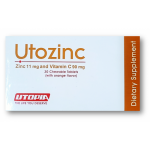
Proprietary name and group
TOBRADEX®
Association of an antibiotic and a corticosteroid.
INDICATIONS :
Ocular inflammations with bacterial infection, or risk of bacterial infection, in patients sensitive to steroids; inflammation of the conjunctiva, the cornea or uvea.
INSTRUCTIONS FOR USE :
– Eye drops :
The normal dosage is one or two drops every four hours; possibly every two hours durir:lg the first two days.The drops should be instilled in keeping with the instructions indicated by the physician, whose guidelines should be rigourously followed. Treatment should not be withdrawn prematurely and should be continued forthe entire period recommended by the physi- cian, even if the patient believes the infection is cured.
Ointment :
Place a small quantity of the ointment (1 to 1.5 cm) in the conjunctival sac three to four times daily or at bedtime as a com- plement to the eye drops.
Instructions for application
1- Lean the head back.
2- Place a finger on the cheek just below the eye and pull down gently until a “V” shaped pocket is formed between the eye and the lower eyelid.
3- Pace a small quantity (1 to 1.5 cm) ofTobradex ointment in the “V” shaped pocket. Do not touch the eye with the tip of the tube.
4- Lower the eyes for a few seconds before closing them.
CASES IN WHICH ADMINISTRATION IS CONTRAINDICATED :
Inflammation of the cornea caused by herpes (dendritic keratitis), a vaccine or chicken pox and many other viral diseases of the cornea and the conjunctiva. Mycobacterial infections of the eye. Diseases of the eye caused by a fungus. Hyper- sensitivity to anyone of the ingredients. Corticoids for use in the eye bring about an increase in the intraocular pressure in 25 % of patients. Forthis reason, Tobradexill should be administered to patients suffering from glaucoma only if the physi- cian considers that the therapeutic benefits exceed the potential risks and only if intraocular pressure is regularly moni-
tored. Tobradex should be administered in cases of acute ocular infection with the presence of pus only if treatment with a com- bined steroid and anti-infection treatment is really necessary because corticoids may mask or aggravate an infection (see Precautions).
ADVERSE EFFECTS :
Possible itching sensation, swelling of eyelids, redness of the conjunctiva and increase in intraocular pressure.
– Possible persistence of inflammation subsequent to an invasion of fungus.
– Possible allergic reaction.
PRECAUTIONS :
Prolonged topical use of corticosteroids may bring about glaucoma, affecting the optic nerve, causing alterations in the vision and the formation of cataracts. If Tobradex is administered for more then ten days, ocular pressure should be
regularly monitored by the physician. Prolonged use of cortlcosterolds may also bring about the following:
– an increased risk of secondary ocular infections;
– a masking or aggravation of an acute infection accompanied by pus;
– the perforation of certain eye tissues that have undergone thinning owing to disease.
There is a possibility of fungal proliferation following prolonged topical treatment with a steroid. As with other antibiotics, prolonged use may bring about the growth of resistant organisms. Treatment should not be withdrawn too early, in order to avoid a renewed outbreak of the infection.
,po “l\)OI adex eye drops-contain benzalkonium chloride and should not oe adrninisteretrwtrltesoft col1t1fen~fns-es-are being worn. Innocuousness and efficacy in infants have not been established.
USE DURING PREGNANCY AND BREAST FEEDING :
Pregnancy
Should be administered only if absolutely necessary.
Breast feeding
Should be administered with caution In ligfi oHlle possibility of appearance of the medicine in the mother’s milk.
DRIVING OF VEHICLES AND OPERATION OF MACHINERY :
Patients wishing to drive a vehicle or operate machinery should bear in mind that the application of an ophthalmic oint- ment may momentarily affect visual acuteness.
MEASURES IN THE EVENT OF AN OVERDOSE :
Given the means of administration, an overdose is unlikely howeveran erdose does occur, the excess amount of the medicine should be flushed from the eye with tap water.
FORM, ROUTE OF ADMINISTRATION AND PACK :
Eye drops: Sterile aqueous ophthalmic suspension (isotonic). Administered in the eye. Available in 5, 10 and/or 15 ml by rnedlcal prescription only.
Ointment: Sterile ophthalmic ointment for topical administration in the eye. 3.5 g tube. Available by medical prescription only.
STORAGE :
The usual precautions observed for medicines apply. Should be kept away from heat and light and out of the reach of chil- dren. Close the container tightly after use. Do not touch the tip of the eyedropper.
SHELF LIFE :
The eye drops should not be used if the bottle has been Op9<1 otQCe than onamOQtll-Close tightly after each use. Unopened, the eye drops may be conserved for 36 months. See the expiry date on the packaging indicated after “Exp” (For example, 06 BB means June, 19BB.) Unopened, the ointment may be conserved for 24 months. See the expiry date on the packaging indicated after “Exp” (For example, 06 BB means June, 19BB.)
COMPOSITION :
– Eye drops: Tobramyclnum 3 mg – Dexamethasonum 1 mg – Benzalkonii chlor. – Tyloxapol – Natrii edetas – Natrii chlor.
Hydroxyethylcell. – Natr. sulfas anhydr. – Ac. sulfur. et/aut Natr. hydrox. – Aqua purificata q.s. ad 1 ml.
– Ointment: Tobramycinum 3 mg – Dexamethasonum 1 mg – Chlorobut. anhydr. – Paraf. liq – Vaselinum q.s. pro 1 g.
MANUFACTURER :
s.a. ALCON-COUVREUR n.v.
Rijksweg 14
2870 Puurs (Belgium

